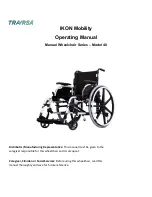
1. Backrest
There are two types of backrest fitted to the wheelchair, either fixed or adjustable. The
adjustable backrest can be folded down by means of a locking mechanism fitted to both
sides of the lower part of the backrest pillars. To fold the backrest down, push on both of
the black plastic levers, then pull back and down on the top part of the backrest. To return
to the original, reverse the procedure, making sure the mechanisms are locked securely.
2. Handles
The handles are designed for the helper to propel the wheelchair. They must not be used
solely for lifting the wheelchair over obstructions or kerbs. Downward pressure must
be applied to the tip bar at the same time to prevent adverse strain on the handles (see
negotiating obstacles) (see fig. 5& 6)
The helper must not place all of their weight on the handles by lifting their feet off the
floor as this will place adverse strain on the handles.
3. Armrest
PVC pads are fixed onto the armrest for comfort and can be replaced as spare parts.
4. Seat Upholstery
Periodically check the upholstery for signs of tears or sagging. Replace immediately if
the seat is damaged. Remember: the seat upholstery is the primary weight – supporting
material.
5. Footplates
The footplates are intended as a foot support only when you are sitting in the wheelchair.
On no account should you stand on the footplates. The heel loops or calf straps (if fitted)
can be used to secure the position of the feet. The footplate assemblies can be adjusted in
height by loosening the nut of the base of the adjustment tube, positioning the plate at the
required height and tightening the nut to secure the assembly.
The footplate supports cannot be adjusted but are moveable from the wheelchair. They
can be swung away to the outside of the wheelchair. To carry out this procedure, press the
release lever and swing the support to the outside of the wheelchair. If the support is to
be removed, lift it upwards. To re-fit and return to the original position, reverse the above
procedure.
6. Castor and bearing
The front wheels have solid puncture proof tyres. These should be checked at regular
intervals to monitor any wear. Wheelchairs become difficult to steer and propel when
surfaces have worn flat. It is recommended that both front tyres are replaced at the same
time to avoid one side of the wheelchair from being higher than the other.
The wheel is secured to the castor fork by an axle bolt and axle nut. Periodically, this bolt
and nut should be checked and tightened if necessary to allow a snug but free spinning fit.
The castor fork swivel allows the wheelchair to be steered. An adjustment locknut is located
under the castor cap. If the locknut is too tight, the wheelchair will be difficult to steer.

















![Dietz AS[01] Operating Instructions Manual preview](http://thumbs.mh-extra.com/thumbs/dietz/as-01/as-01_operating-instructions-manual_2495921-01.webp)











